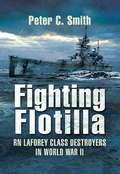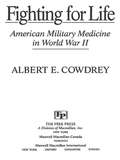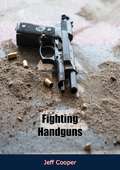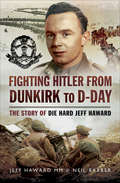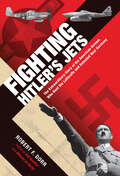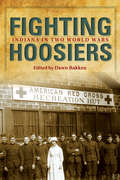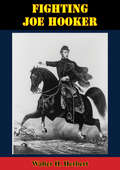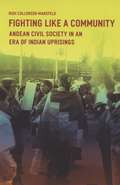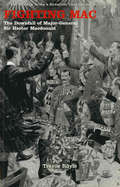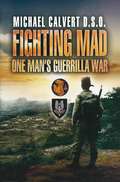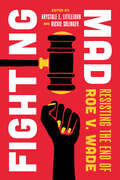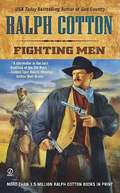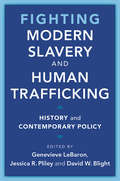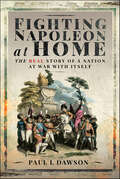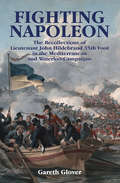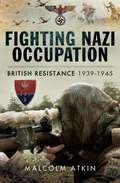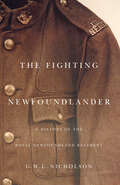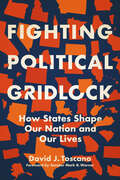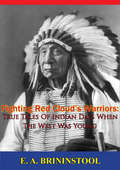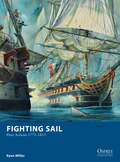- Table View
- List View
Fighting Flotilla: RN Laforey Class Destroyers in World War II
by Peter C. SmithThe Laforays were the largest, most powerfully armed and successful ships of this type to see frontline action with the Royal Navy in WWII. They were also the handsomest warships to see service and presented a perfect combination of power and speed. They were assigned to the most dangerous theaters of war including Force H, sailing between Gibraltar and Malta, from where they operated against the German supply lines to North Africa. They escorted minelayers into the German backyard in the North Sea and their convoy escort work in the North Atlantic proved them to be highly effective hunter killers of the U-Boat packs that threatened every cargo ship carrying vital supplies to the UK. Such was the pace of their war, that out of the eight ships of the class only one survived the war.The book also includes chapters on their origin, planning and building, wartime operations and indices cover weapon systems, general fittings and complements and battle honors for each ship in the class.
Fighting For Life: American Military Medicine in World War II
by Albert E. CowdreyFought on almost every continent, the Second World War confronted American GIs with unprecedented threats to life and health posed by combat on Arctic ice floes and African deserts, steamy island jungles and remote mountain villages, the stratosphere and the depths of the sea. Service men were assaulted by frostbite, malaria, shrapnel, and landmines. But the demands of war provoked unparalleled medical advances in the years 1941-45, as well. In a war that unleashed the technology of destruction as no previous conflict had, the tale of those whose duty it was to save lives in World War II, not destroy them, has remained untold. Now, award-winning author Albert Cowdrey has written the first comprehensive history of one of the most important yet underappreciated weapons of World War II - America's extraordinary military medicine. Cowdrey tells the remarkable story of how American units developed and implemented new technology under dire pressures, succeeding so brilliantly that World War II became the first American war in which more men died in combat than of disease. Penicillin brought the antibiotic revolution to the battlefield, air evacuation plucked the wounded from jungles and deserts, and a unique system brought blood, still fresh from America, to our soldiers all over the world. Surgeons working just behind the front lines stabilized the worst cases, while physicians and public health experts suppressed epidemics and cured exotic diseases. Psychiatrists, nurses and medics all performed heroic feats amidst unspeakable conditions. Together, these men and women improvised medical miracles on the battlefield that could not have been imagined by practitioners in peacetime. Cowdrey recalls those triumphant years when Americans, blessed with the skill, courage, and dedication of a formidable medical fighting force, achieved a spectacular victory.
Fighting France: From Dunkerque to Belport (Hesperus Modern Voices)
by Edith Wharton Colm TóibínAs nuanced in her observations of human behavior as she is in her vivid depictions of French landscape and architecture, Wharton fully exploited her unique position as consort to Walter Barry, president of the American Chamber of Commerce in Paris, which allowed her unparalleled access to life in the trenches. Sensitive without sentimentality, and offering a valuable and extremely rare female perspective of a war dominated by the male viewpoint, this series of articles is nothing less than an inspirational testament to the strength of the human spirit at a time of the greatest adversity.
Fighting Handguns: History, Adventure And Romance Of Handguns From The Muzzle Loader To Modern Magnums
by Jeff CooperIn Fighting Handguns, author Jeff Cooper not only takes the reader through the development of this weapon from its beginnings in mid-16th-century Europe through the various iterations of single- and double-action revolvers and semiautomatic pistols, he also discusses some important aspects of carrying and shooting a fighting handgun under combat conditions.“For good or ill, man is a fighting animal. While most feel that this is an unmitigated evil, it may, like most aspects of nature, have its positive side. Certainly man’s combative nature is responsible for most of the massive tragedy of history, but it’s possible that history of any sort just wouldn’t have happened had it not been characteristic of the race to struggle against its environment. And man’s environment, of course, includes man. A placid, gentle, contented creature—a koala, for instance—is nice to contemplate but does not progress, and if it encounters a challenge it simply dies. Whether progress, at the price of a fighting disposition, is worth it is a question, but it’s a bit on the academic side. Man is the way he is, and gets along as he must. Being human, we are involved in strife. Much as we may deplore this, we must master the techniques of strife or perish.“This book is devoted to one of these techniques—the one-hand firearm as used by man against man.”—Jeff Cooper
Fighting Hitler from Dunkirk to D-Day: The Story of Die Hard Jeff Haward
by Jeff Haward Neil BarberFighting Hitler From Dunkirk to D-Day is the compelling story of a man belonging to a group of which there are now very few survivors. Jeff Haward MM is a pre-war Territorial Army soldier who enlisted merely for something to do in the evenings. Consequently, he fought throughout the entirety of the Second World War. Jeff is a 'Die Hard', the historic name given to men of the famous Middlesex Regiment. He joined the 1/7th Battalion, a machine-gun battalion, equipped with the British Army's iconic Vickers medium machine gun.Following evacuation from Dunkirk, the 1/7th, while refitting and re-equipping, carried out coastal defence duties in preparation for the German invasion. So desperate was the situation that on sentry duty, the one rifle per section had to be handed to the next sentry, along with the only ammunition available three rounds!In 1941, they were attached to the famous 51st Highland Division. The less than enthusiastic welcome from the Jocks gradually evolved into respect following the Middlesex's performance at El Alamein and the subsequent campaigns in North Africa, Sicily, Normandy and North West Europe.Following the Reichswald battle, in March 1945, Jeff was surprised to hear that he had been awarded the Military Medal for bravery and was subsequently awarded the ribbon by none other than Field Marshal Sir Bernard Montgomery.Jeff Haward's experiences, those of a normal soldier, make fascinating reading and throw new light on the use of such Vickers gun battalions during the war.
Fighting Hitler's Jets: The Extraordinary Story of the American Airmen Who Beat the Luftwaffe and Defeated Nazi Germany
by Robert F. DorrFighting Hitler's Jets brings together in a single, character-driven narrative two groups of men at war: on one side, American fighter pilots and others who battled the secret “wonder weapons” with which Adolf Hitler hoped to turn the tide; on the other, the German scientists, engineers, and pilots who created and used these machines of war on the cutting edge of technology. Written by Robert F. Dorr, renowned author of Zenith Press titles Hell Hawks!, Mission to Berlin, and Mission to Tokyo, the story begins with a display of high-tech secret weapons arranged for Hitler at a time when Germany still had prospects of winning the war. It concludes with Berlin in rubble and the Allies seeking German technology in order to jumpstart their own jet-powered aviation programs. Along the way, Dorr expertly describes the battles in the sky over the Third Reich that made it possible for the Allies to mount the D-Day invasion and advance toward Berlin. Finally, the book addresses both facts and speculation about German weaponry and leaders, including conspiracy theorists’ view that Hitler escaped in a secret aircraft at the war’s end. Where history and controversy collide with riveting narrative, Fighting Hitler’s Jets furthers a repertoire that comprises some of the United States’ most exceptional military writing.
Fighting Hoosiers: Indiana in Two World Wars
by Dawn E. BakkenFighting Hoosiers: Indiana in Two World Wars tells the compelling, heartbreaking, and breathtaking stories of some of the hundreds of thousands of Hoosiers who served their country during the First and Second World Wars. Drawn from the rich holdings of the Indiana Magazine of History, a journal of state and midwestern history published since 1905, the collection includes original diaries, letters and memoirs, as well as research essays—all of them focused on Hoosiers in the two world wars. Readers will meet Alex Arch, a Hungarian-born immigrant who was the first American to fire a shot in World War I; Maude Essig, a nurse serving with the American Red Cross in wartime France; Kenneth Baker, a soldier in the Army Signal Corps, who crawled across French fields (sometimes over and around dead bodies) to lay phone lines for military communications; and Bernard Rice, a combat medic who witnessed the liberation of the Dachau concentration camp in 1945. Indiana's brave men and women like these have served with distinction in the armed forces since the earliest days of the Indiana Territory. Fighting Hoosiers offers a compelling glimpse at some of their remarkable stories.
Fighting Joe Hooker
by Walter H. Hebert"I have placed you at the head of the Army of the Potomac. Of course I have done this upon what appear to me to be sufficient reasons. And yet I think it best for you to know that there are some things in regard to which, I am not quite satisfied with you."With this opening sentence in a two-page letter from Abraham Lincoln, Union general Joseph Hooker (1814-79) gained a prominent place in Civil War history. Hooker assumed command of an army demoralized by defeat and diminished by desertion. Acting swiftly, the general reorganized his army, routed corruption among quartermasters, improved food and sanitation, and boosted morale by granting furloughs and amnesties. His hour of fame and the test of his military skill came in the May 1863 battle of Chancellorsville. It was one of the Union Army's worst defeats; shortly thereafter Hooker's resignation was accepted.This definitive biography of a man who could lead so brilliantly and yet fall so ignominiously remains the only full-length treatment of Hooker's life. His renewal as an important commander in the western theater during the Chattanooga and Atlanta campaigns is discussed, as is his life before and after his Civil War military service.--Print Ed.
Fighting Like a Community: Andean Civil Society in an Era of Indian Uprisings
by Rudi Colloredo-MansfeldThe indigenous population of the Ecuadorian Andes made substantial political gains during the 1990s in the wake of a dynamic wave of local activism. The movement renegotiated land development laws, elected indigenous candidates to national office, and successfully fought for the constitutional redefinition of Ecuador as a nation of many cultures. Fighting Like a Community argues that these remarkable achievements paradoxically grew out of the deep differences--in language, class, education, and location--that began to divide native society in the 1960s. Drawing on fifteen years of fieldwork, Rudi Colloredo-Mansfeld explores these differences and the conflicts they engendered in a variety of communities. From protestors confronting the military during a national strike to a migrant family fighting to get a relative released from prison, Colloredo-Mansfeld recounts dramatic events and private struggles alike to demonstrate how indigenous power in Ecuador is energized by disagreements over values and priorities, eloquently contending that the plurality of Andean communities, not their unity, has been the key to their political success.
Fighting Mac: The Downfall of Major-General Sir Hector Macdonald
by Trevor RoyleOn a spring morning in 1903, Major-General Sir Hector Macdonald, one of Britain's greatest military heroes, took his life in a hotel room in Paris. A few days later he was buried hastily in an Edinburgh cemetary as his fellow countrymen tried to come to terms with the fact that one of Scotland's most famous soldiers had ended his life rather than face charges against his character.The suicide and its aftermath created a national scandal and one which still reverberates long after those dramatic events - it is now clear that the official files dealing with his case, the papers of the Judge Advocate have been destroyed. Macdonald or 'Fighting Mac' as he was known to an adoring public, was no ordinary soldier. A crofter's son who had risen from the ranks in the Victorian army, he covered himself with glory during a long and successful military career and in 1898 was widely acknowledged as the true hero of the Battle of Omdurman, which cemented British Imperial rule in Anglo-Egyptian Sudan. Everything lay at his feet - a knighthood, honours, the respect of fellow generals such as Roberts and Kitchener - but Macdonald's career came to a shocking full stop when he stood accused of homosexuality and was ordered to face a court martial. Unable to come to terms with the disgrace, he committed suicide. That should have been the end of his story but so powerful was the myth created by Fighting Mac that people refused to believe he was dead. Soon rumours were circulating that Macdonald had faked his death and had adopted the persona of a prominent Prussian officer, the future Field Marshal August con Mackensen, one of Germany's great leaders during the First World War. FIGHTING MAC tells the true story behind his disgrace and sheds new light on the myths....
Fighting Mad: One Man's Guerrilla War
by Michael CalvertMichael Calvert was one of the legendary figures of the Second World War. He hit the headlines as 'Mad Mike' after the first Chindit campaign in 1943, with a reputation as a tough and daring leader of guerrilla troops. He was one of the first men selected for the Chindits by the controversial General Orde Wingate. He became Wingate's right-hand man - both in fierce jungle fighting and in battles against stick-in-the-mud staff officers. His speciality was penetrating behind enemy lines. Mad Mike fought in the snow and ice of Norway, in the steaming jungles of Burma, and on the battlefields of Europe where in 1945 he commanded the crack Special Air Service Brigade.
Fighting Mad: Resisting the End of Roe v. Wade (Reproductive Justice: A New Vision for the 21st Century #8)
by Krystale E. Littlejohn and Rickie SolingerA fierce and galvanizing reminder that resistance is everywhere in the fight for abortion and reproductive justice in the United States. Fighting Mad is a book about what "reproductive justice" means and what it looks like to fight for it. Editors Krystale E. Littlejohn and Rickie Solinger bring together many of the strongest, most resistant voices in the country to describe the impacts of the Supreme Court's Dobbs decision on abortion access and care. The essayists and change agents gathered in Fighting Mad represent a remarkable breadth of expertise: activists and artists, academics and abortion storytellers, health care professionals and legislators, clinic directors and lawyers, and so many more. They discuss abortion restrictions and strategies to provide care, the impacts of criminalization, efforts to protect the targeted, shortcomings of the past, and visions for the next generation. Fighting Mad captures for the social and historical record the vigorous resistance happening in the early post-Roe moment to show that there are millions on the ground fighting to secure a better future.
Fighting Men
by Ralph CottonCivil War veteran and former schoolmaster Sherman Dahl rides the Southwest as a gun for hire. Known by both the law and the lawless as "The Teacher", Dahl sells his services to those seeking justice-and is relentless in his pursuit of wanted men. .
Fighting Modern Slavery and Human Trafficking: History and Contemporary Policy (Slaveries since Emancipation)
by David W. Blight Jessica R. Pliley Genevieve LeBaronOver the last two decades, fighting modern slavery and human trafficking has become a cause célèbre. Yet large numbers of researchers, non-governmental organizations, trade unions, workers, and others who would seem like natural allies in the fight against modern slavery and trafficking are hugely skeptical of these movements. They object to how the problems are framed, and are skeptical of the “new abolitionist” movement. Why? This book tackles key controversies surrounding the anti-slavery and anti-trafficking movements head on. Champions and skeptics explore the fissures and fault lines that surround efforts to fight modern slavery and human trafficking today. These include: whether efforts to fight modern slavery displace or crowd out support for labor and migrant rights; whether and to what extent efforts to fight modern slavery mask, naturalize, and distract from racial, gendered, and economic inequality; and whether contemporary anti-slavery and anti-trafficking crusaders' use of history are accurate and appropriate.
Fighting Napoleon at Home: The Real Story of a Nation at War With Itself
by Paul L. DawsonFrom the sun-baked sierras of Spain, through the stormy waters off Cape Trafalgar to the muddy and bloody fields of Waterloo, Britain’s soldiers and sailors were notching up victories which set the country on the path to becoming the greatest power on the planet. We like to imagine the country was unified against a common enemy, France, and the Tyrant of Europe – Napoleon. Yet if we scratch the surface, we find a nation not just at war with France but with itself. The great successes of Wellington and Nelson, and the glamour of Regency London, cover over the cracks of a divided society, of riots across the industrial north and widespread political opposition. Huge swathes of the country hated the war, booed and hissed at soldiers and ‘lobbed turds’ at the Scots Greys in Halifax. There were repeated ‘Peace Petitions’ which sought to stop the war – and even to prevent the British Army fighting at Waterloo. Armed Associations of gentlemen volunteers and Local Militias led the call to close down the debate on social and democratic reform, while on the other hand thousands of English reformers heeded the call from France and hundreds actually headed to France, with many thousands more believing that the time had come, when its young men were needed to fight for King and Country, for reform. The burgeoning middle class had no vote in parliament; rapidly expanding industrial towns and cities had no MPs, yet small villages – pocket boroughs – often had two. The burden of taxation fell on those least able to afford it; enclosure of common land; corn laws; restrictions on the freedom of expression; the endless killing, all fed into an undercurrent of political dissent that was ideologically opposed to the loyalist cause. It was a battle for the very sole of Britain. For the first time, the shocking reality of life in Britain, during what is often portrayed as being its greatest era, is told through diaries, letters, and newspaper comments. Fighting Napoleon at Home is a startling portrayal of the society from which the soldiers and sailors were drawn and exactly what it was they were fighting to defend. It will become essential reading for anyone attempting to understand why Britain’s aristocracy had to stop Napoleon at any cost and suppress the dangerous ideals of liberté, égalité, fraternité.
Fighting Napoleon: The Recollections of Lieutenant John Hildebrand 35th Foot in the Mediterranean and Waterloo Campaigns
by Gareth Glover&“These lively and entertaining memoirs provide an intriguing counterpoint to Wellington&’s better-known operations in the Iberian Peninsula&” (Julian Stockwin, author of the Thomas Kydd series). It is often forgotten that Britain&’s struggle against Napoleon ranged across the continents, and the extensive operations of the Royal Navy and the British Army in the Mediterranean were key battlegrounds in this prolonged war of attrition. Even when Napoleon considered himself the master of Europe, he was unable to control the Mediterranean. Lt. John Hildebrand arrived in the Mediterranean as part of the garrison of Malta in 1810. He was then involved in the defense of the island of Sicily; the campaign to capture the Ionian Islands; the siege of Ragusa; and the Occupation of Corfu. With the war ending in 1814, John and his regiment returned home, only to be sent to Belgium when Napoleon escaped from Elba in 1815. The regiment was not involved at Waterloo, but was at Hal, where it guarded Wellington&’s flank during the battle. He then marched to Paris with the army. &“Napoleonic students will enjoy this refreshingly different slant on Napoleonic warfare.&” —Stuart Asquith, author of Stuart Asquith&’s Wargaming 18th Century Battles &“Essential reading for military historians and collectors of Napoleonic War era artifacts and militaria.&” —The Armourer Incorporating Classic Arms & Militaria
Fighting Nazi Occupation: British Resistance 1939–1945
by Malcolm Atkin&“Everyone knows about the Home Guard but what about the other Secret Intelligence Services (SIS and M16)? You can read about them in [this book].&” —This England When Winston Churchill made his &“we shall never surrender&” speech in 1940, he was speaking in the knowledge that Britain&’s Secret Intelligence Service was planning a civilian British resistance movement to mobilize after the country had been occupied. Britain&’s planning for clandestine warfare developed out of a fierce battle between the Secret Intelligence Service and the War Office for the control of guerrilla warfare and conflicting ideas over the legitimacy of armed civilians. A multi-layered system of secret organizations was the result. The Auxiliary Units are the best known of these &“ungentlemanly&” forces, but in this perceptive new study based on painstaking original research, Malcolm Atkin clearly demonstrates that they were never intended as a resistance organization. Instead, they were designed as a short-term guerrilla force, whilst their Special Duties Branch was designed to spy on the British public as much as any Nazi invader. Meanwhile, deep in the shadows, was the real resistance organization—Section VII of SIS. Malcolm Atkin&’s conclusions will cause controversy among military historians and will change our understanding of the preparations made in Britain to resist Nazi occupation in the Second World War. &“[A] detailed yet accessible historical study.&” —ProtoView
Fighting Newfoundlander
by Gerald W.L. NicholsonThe Fighting Newfoundlander is a vivid history of the Royal Newfoundland Regiment - the "Blue Puttees" - and its heroic contributions to the war effort. Gerald Nicholson details the harrowing experiences of the Newfoundland Regiment (the only Canadian unit) at Gallipoli and later at Beaumont Hamel where 710 of the 801 officers and men who took part in the assault were casualties. He also follows them to the Third Battle of Ypres and Cambrai, for which they were granted the title "Royal" - the only army unit to receive such a distinction during World War I.
Fighting Newfoundlander (Carleton Library Series)
by Gerald W.L. NicholsonThe Fighting Newfoundlander is a vivid history of the Royal Newfoundland Regiment - the "Blue Puttees" - and its heroic contributions to the war effort. Gerald Nicholson details the harrowing experiences of the Newfoundland Regiment (the only Canadian unit) at Gallipoli and later at Beaumont Hamel where 710 of the 801 officers and men who took part in the assault were casualties. He also follows them to the Third Battle of Ypres and Cambrai, for which they were granted the title "Royal" - the only army unit to receive such a distinction during World War I.
Fighting Political Gridlock: How States Shape Our Nation and Our Lives
by David J. ToscanoIn this profoundly polarized era, the nation has been transfixed on the politics of Washington and its seemingly impenetrable gridlock. Many of the decisions that truly affect people’s lives, however, are being made not on the federal level but in the states. Faced with Washington’s political standoff, state governments are taking action on numerous vital issues, often impacting citizens and their communities far more than the decision makers in D.C. Despite this, few Americans really understand their state governments or the issues they address. In Fighting Political Gridlock, David Toscano reveals how the states are working around the impasse in Washington and how their work is increasingly shaping society.Long a central figure in one of the most important legislative bodies in the nation, the Virginia House of Delegates, Toscano brings a unique expertise to this urgent and timely discussion. Beginning with an analysis of state responses to COVID-19, including the processes and consequences of declaring states of emergency, he goes on to detail how various states are attacking issues in different ways–from education and voting to criminal justice and climate change–and provides a broad overview of how state actions affect our system of federalism. Toscano concludes with a call to action and civic engagement, including suggestions for how citizens and public officials can revitalize American democracy.
Fighting Red Cloud’s Warriors: True Tales Of Indian Days When The West Was Young
by E. A. BrininstoolTHE winning of the West was no child's play! It was war--war of the most brutal and inhuman type on the part of both Indians and whites. The Indian was fighting for his home, his commissary, his lands--lands ceded him through solemn treaty with the United States government--and what man, of any nation (if he is any sort of man) will not fight "for home and native land"?The white man fought to advance the cause of civilization, irrespective (in most instances) of the rights of the Indian, and without regard to his future existence. Civilization won--and to civilization's shame, it was at the cost of unnumbered thousands of lives and the shedding of much human blood of both whites and reds.I am not a believer in the old adage that "the only good Indian is a dead Indian." My sympathy is with the red man. The early white traders who trafficked with the Indian were, as a rule, a class of men of little conscience and few scruples, who would stoop to any deceit or trickery to rob the Indian of his furs and pelts. It was the early trader who introduced whiskey among the Indian tribes; who, through fraud and knavery, turned the red man against the whites of whatever class. This was the beginning of the hatred and contempt which made all white men, good or bad, soon look alike to the warring savage.In this volume of the "Frontier Series" I have written of a few of the most noted battles between the red man and the white man. As in the previous volume, no fiction is employed in these pages. Every incident related actually occurred, and is a part of the history of the old West. Some biographical sketches of noted frontier characters are included. The chapter on the destruction of the buffalo may well make the present-day sportsman pause and reflect.
Fighting Rommel: The British Imperial Army in North Africa during the Second World War, 1941–1943
by Kaushik RoyFighting Rommel examines how and why some armies innovate under pressure while others do not. Focusing on the learning culture of the British Imperial Forces, it looks at the Allied campaign during the Second World War against the Afrika Korps of Rommel. The volume highlights the hitherto unexplored yet key role of the British Indian Army, the largest volunteer force in the world. It also introduces ‘learning culture’ as a heuristic device. Further, it goes on to analyze military innovation on the battlefield, in victory and defeat. A major intervention in the study of the Second World War, this book will be indispensable to scholars and researchers of military history, especially British and German, battlefield history, and defence and strategic studies.
Fighting Sail - Fleet Actions 1775-1815
by Peter Dennis Ryan MillerIn the years between 1776 and 1815, grand square-rigged sailing ships dominated warfare on the high seas. Fighting Sail is a tabletop wargame of fleet battles in this age of canvas, cannon, and timbers. Players take on the roles of fleet admirals from one of eight different national fleets: America, Britain, France, Spain, The Netherlands, Portugal, Russia and Sweden in battles ranging from the American War of Independence to the Napoleonic Wars and the War of 1812. Each fleet has access to different ships, tactics, and command personalities - each with its own strengths and weaknesses. Offering a unique blend between detail and simplicity, the scenarios included enable the recreation of historic actions or 'what-if' scenarios. Join the battle and experience the adventurous age of the fighting sail!
Fighting Scholars: Habitus and Ethnographies of Martial Arts and Combat Sports (Key Issues In Modern Sociology Ser.)
by Dale C. Spencer Raul Sanchez GarciaFighting Scholars brings to the fore the ethnographic study of combat sports and martial arts as a means of exploring embodied human existence. The book's main claim is that such activities represent privileged grounds to access different social dimensions, such as emotion, violence, pain, gender, ethnicity and religion. To explore these dimensions, the concept of 'habitus' is presented prominently as an epistemic remedy for the academic distant gaze of the effaced academic body. The different contributions of this volume are aligned within the same project that began to crystallize in Loïc Wacquant's 'Body and Soul': the construction of a 'carnal sociology' that constitutes an exploration of the social world 'from' the body. The book is divided into three sections. In the first section, the editors introduce the field, providing a typology of existing literature. The second section contains the contributions of the authors, discussing their respective approaches to embodied ethnography, their use of the concept of 'habitus', and ethnographic findings. The third section contains a conclusion by the editors - reflecting on existing conceptions of 'habitus' and interdisciplinary possibilities for rethinking the concept - and an epilogue by Loïc Wacquant critically assessing the whole volume.
